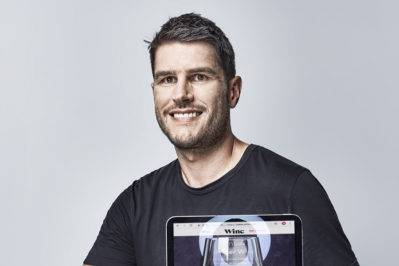Watch a movie online, and Netflix will recommend another its algorithms think you’ll like. Order a pair of shoes, and Zappos will suggest the next pair you should buy. Why shouldn’t the wine you drink be tailored to your preferences?
The company Winc began in 2012 with that premise. It started as a personalized subscription service, recommending wines to customers based on their existing preferences. They’ve since expanded beyond selling third-party bottles into developing their own wines, based on to their predictions of changing consumer tastes. On this episode of Mastering Innovation on SiriusXM Channel 132, Business Radio Powered by The Wharton School, Winc co-founders Brian Smith and Geoff McFarlane shared how they’re using data to anticipate customer desires and get ahead of the next big trend.
An excerpt of the interview is transcribed below. Listen to more episodes here.
Transcript
Saikat Chaudhuri: You guys have a very data-driven approach to capturing not only what customers like but also trying to predict what else they might like. It’s a marked departure from how we traditionally operate in the wine business, which is more the other way around. It’s kind of a push strategy, as opposed to kind of figuring out what the customers want or might want. It’s like Netflix in the media industry: everybody else creates content and sees what people like, but Netflix is analyzing the data and saying, “You know what? I think 10,000 users might like a show with attributes A, B, C, and D. Let’s go get someone who can make that for us and then trial it.” So it seems a bit more like that Netflix approach.
I apologize if I’m simplifying wine to some media thing, but you know what I mean, there are creative elements in both. I’d love to hear both of your comments on this.

Geoff McFarlane: I think we complement each other in the way that we come at it. We dig into the data and try to find trends in what customers are liking, what we think is changing in the industry, and what we think is changing with consumers that the industry isn’t seeing. When I talk about the larger wine industry, someone finds a product that starts working or gets a buyer excited, and then everyone else fast follows and jumps in on that product.
I think we’re able to see what consumers are wanting a little bit ahead of how they’re rating and how they’re interpreting products, much faster than the traditional wineries. And so we’re trying to define those trends in the data. Then I’ll communicate those trends to Brian, and then Brian will put on his creative hat and try to create products that fit those consumers.
The next step in the flywheel is sending those newly developed products that Brian and his team create out to customers. And then exactly like you said with Netflix, we get data from a small group of consumers to see if that product works. If it does, we invest much more heavily in the production and marketing of that product and then begin to scale that product.
Brian Smith: I’ll just add that I think you touched on an interesting point. Geoff mentioned it too: the wine business to some degree is push. You’re trying to get onto the shelf, but once you reach the shelf, it’s somewhat static. I think if you look at any product today and today’s consumer, they’re connecting with brands in a different way. The two-way conversation is extremely valuable for us because the trust we build with our audience and the data that we have allows us to be more creative, potentially with a higher rate of success.

The other important thing that we’re seeing is that the two-way conversation doesn’t start just when you launch a wine and get feedback and responses from your customers. It continues through the life-cycle of that brand or that concept.
We really have a new playbook for connecting with consumers and staying connected with consumers in the wine space. As we pull a brand out or build that project and launch into retail and restaurant, we’ve got a built-in consumer that we’re still connected with. There’s a whole social media and digital marketing playbook that we can layer in to connect with our consumers and keep our brand top of mind that just doesn’t exist in the traditional wine space. So it’s important in the initial phases and trialing and seeding, but it’s also a very important relationship for us long-term.
Chaudhuri: I think that’s fascinating, and that’s your competitive advantage both in terms of how you use the data but also in terms of this continual connection.
Are the traditional wineries paying attention, and do you think that they could emulate something like that in order to respond to you?
McFarlane: I think they’re certainly watching. They’re consistently watching what’s going out in the space. We’ve been public and been driving, and as we go out and advertise to customers, I think they’ve been following along.
Certainly I think they can try to emulate us, but I think Netflix and the big media companies are good examples of this. It’s really hard to create the culture internally and set a structure internally to be able to build a truly innovative culture, one that is focused on continually trying to change for the customer. And these big wine companies have built great businesses over the last 40 or 50 years in partnering with distributors, partnering with retailers, owning shelves in retailers — not really having to communicate with customers, but being able to own the shelf space and then be able to trade products in and out to find the highest velocity products in those retail stores.
To really go in and change the very nature of how they do business and how they talk to the consumer is a tough challenge. Even with the dollars and resources, I think it’s very difficult to change the overall culture of your company. And I think we’ve really built our entire culture and our entire team around a focus on innovation and starting with the customer.
About Our Guests
As an entrepreneur with over fifteen years of experience in hospitality, including building and financing high-end bars and restaurants, Geoff McFarlane believes that the authentic connection between the customer, brand, and product is the key to success in a consumer-driven world. He co-founded Winc after seeing how disconnected consumers were from the winemaking and wine selling process. Under his leadership, Winc has established a data driven and customer-oriented approach that is unique within the wine industry. He’s also has successfully grown the company to over 80 employees, $169M in revenue, and a compound annual growth rate (CAGR) of 92% since the company’s launch in 2011.
Brian Smith is driven by a passion to share great wine with as many people as possible. The role of Winc co-founder and COO furthers his mission to create and connect great products with today’s consumer. As COO Brian combines his years of experience as a sommelier, winemaker and brand builder to oversee the world’s most innovative and culturally relevant wine program. A firm believer in creative collaboration, Brian led Winc to partner with Charity Water, Baja East and Jonathan Simkhai, among others. Brian and his team of winemakers carefully craft more than 100 wines a year from grape to glass. Prior to Winc, Brian founded successful finance and fashion startups. His previous wine experience includes creating the wine program for the tech-enabled Clo Wine in New York and founding the millennial cult brand Jolie Folle rosé.Smi



